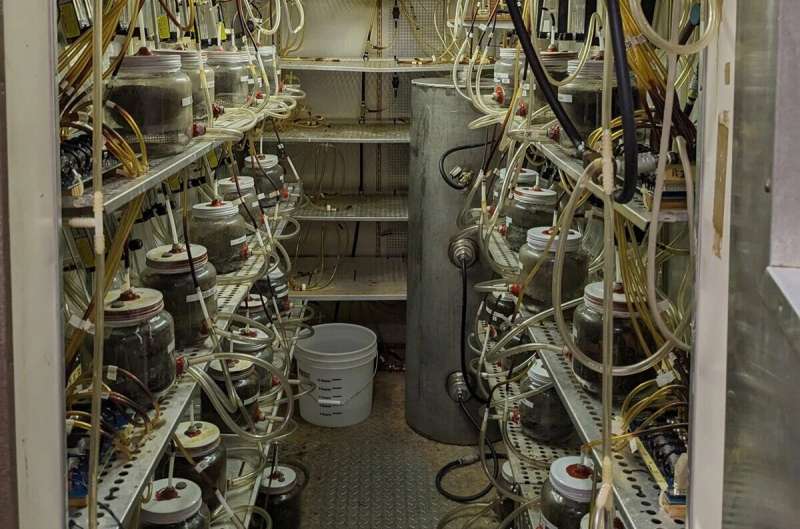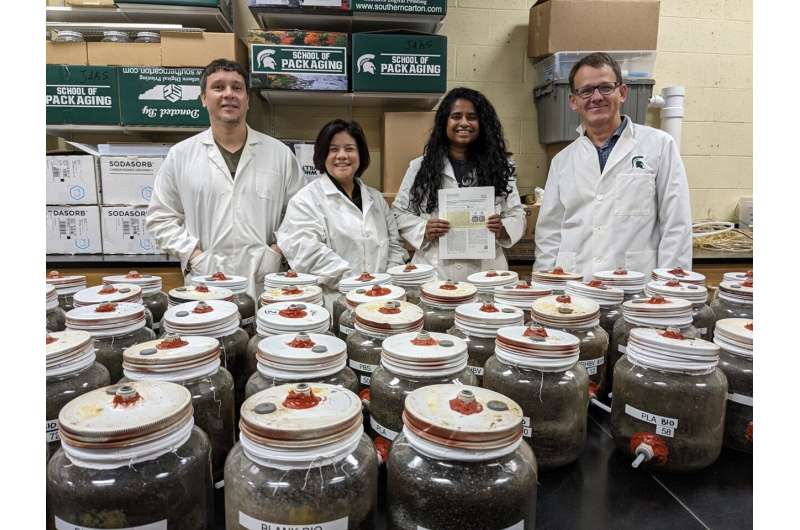This article has been reviewed according to Science X's editorial process and policies. Editors have highlighted the following attributes while ensuring the content's credibility:
fact-checked
peer-reviewed publication
trusted source
proofread
Putting starch into bio-based polymer makes bioplastics more compostable

Researchers from Michigan State University's top-ranked School of Packaging have developed a way to make a promising, sustainable alternative to petroleum-based plastics more biodegradable.
A team led by Rafael Auras has made a bio-based polymer blend that's compostable in both home and industrial settings. The work is published in the journal ACS Sustainable Chemistry & Engineering.
"In the U.S. and globally, there is a large issue with waste and especially plastic waste," said Auras, MSU professor and the Amcor Endowed Chair in Packaging Sustainability.
Less than 10% of plastic waste is recycled in the U.S. That means the bulk of plastic waste ends up as trash or litter, creating economic, environmental and even health concerns.
"By developing biodegradable and compostable products, we can divert some of that waste," Auras said. "We can reduce the amount that goes into a landfill."
Another bonus is that plastics destined for the compost bin wouldn't need to be cleaned of food contaminants, which is a major obstacle for efficient plastic recycling. Recycling facilities routinely must choose between spending time, water and energy to clean dirty plastic waste or simply throwing it out.
"Imagine you had a coffee cup or a microwave tray with tomato sauce," Auras said. "You wouldn't need to rinse or wash those, you could just compost."
PLA and a 'sweet spot' for starch
The team worked with what's known as polylactic acid, or PLA, which seems like an obvious choice in many ways. It's been used in packaging for over a decade, and it's derived from plant sugars rather than petroleum.
When managed properly, PLA's waste byproducts are all natural: water, carbon dioxide and lactic acid.
Plus, researchers know that PLA can biodegrade in industrial composters. These composters create conditions, such as higher temperatures, that are more conducive to breaking down bioplastics than home composters.
Yet, the idea of making PLA compostable at home seemed impossible to some people.

"I remember people laughing at the idea of developing PLA home composting as an option," said Pooja Mayekar, a doctoral student in Auras' lab group and the first author of the new report. "That's because microbes can't attack and consume PLA normally. It has to be broken down to a point where they can utilize it as food."
Although industrial compost settings can get PLA to that point, that doesn't mean they do it quickly or entirely.
"In fact, many industrial composters still shy away from accepting bioplastics like PLA," Auras said.
In its experiments, supported by the U.S. Department of Agriculture and MSU AgBioResearch, the team showed that PLA can sit around for 20 days before microbes start digesting it in industrial composting conditions.
To get rid of that lag time and enable the possibility of home composting, Auras and his team integrated a carbohydrate-derived material called thermoplastic starch into PLA. Among other benefits, the starch gives composting's microbes something they can more easily chow down on while the PLA degrades.
"When we talk about the addition of starch, that doesn't mean we just keep dumping starch in the PLA matrix," Mayekar said. "This was about trying to find a sweet spot with starch, so the PLA degrades better without compromising its other properties."
Fortunately, postdoctoral researcher Anibal Bher had already been formulating different PLA-thermoplastic starch blends to observe how they preserved the strength, clarity and other desirable features of regular PLA films.
Working with doctoral student Wanwarang Limsukon, Bher and Mayekar could observe how those different films broke down throughout the composting process when carried out at different conditions.
"Different materials have different ways of undergoing hydrolysis at the beginning of the process and biodegrading at the end," Limsukon said. "We're working on tracking the entire pathway."
The team ran these experiments using systems that Auras and lab members, past and present, largely built from scratch during his 19 years with MSU. The equipment the researchers have access to outside their own lab in the School of Packaging also makes a difference.
"Working with Dr. Auras, the School of Packaging, MSU—it's great," Bher said. "Because, at some point, we want to be making actual products. We are using facilities around campus to make materials and test their properties. MSU offers a lot of resources."
"There's a reason why this is one of the best schools for packaging," Mayekar said.
More information: Pooja C. Mayekar et al, Breaking It Down: How Thermoplastic Starch Enhances Poly(lactic acid) Biodegradation in Compost─A Comparative Analysis of Reactive Blends, ACS Sustainable Chemistry & Engineering (2023). DOI: 10.1021/acssuschemeng.3c01676
Journal information: ACS Sustainable Chemistry & Engineering
Provided by Michigan State University





















